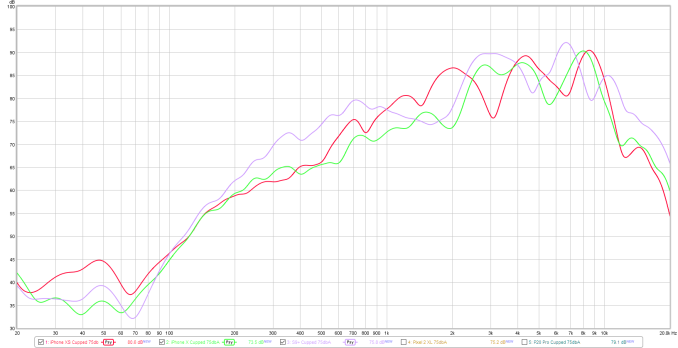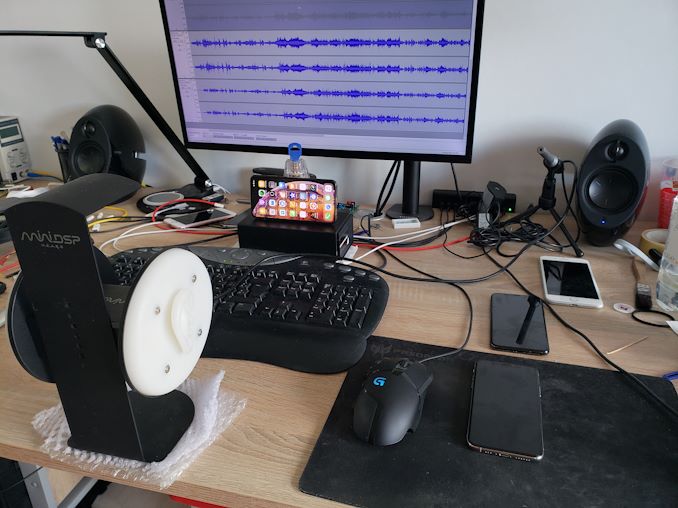The iPhone XS & XS Max Review: Unveiling the Silicon Secrets
by Andrei Frumusanu on October 5, 2018 8:00 AM EST- Posted in
- Mobile
- Apple
- Smartphones
- iPhone XS
- iPhone XS Max
Camera Video Recording
In terms of video recording, the iPhone XS promises an improved dynamic range in modes up to 30fps. What this likely means is that the phone’s able to capture in HDR mode in the 30fps modes, doing the same kind of processing we also see in SmartHDR still pictures.
Also something I’ve dreaded on iPhones for years; the new iPhone XS finally introduces stereo audio recording. Why it took Apple such a long time to finally introduce stereo recording is something that boggles the mind, but, let’s not complain, as we now finally have it on the new generation.
iPhone XS: iPhone X:
Comparing the iPhone XS video to the iPhone X, there’s one thing that is immediately very evident: the new XS is able to produce much better image stabilisation than last year’s flagship. Indeed, it looks like Apple vastly improved the OIS/EIS on the new phones, as the wobble that happens when walking is gone on the XS.
Audio recording finally is up to par, and we can hear the wind and rustling leaves of the trees around us. I think Apple might still have to work a bit on the wind noise cancellation, as in some parts the audio sounded as if it was inside a tube.
In terms of image quality, Apple’s claims of the improved dynamic range are very much verified. The phone showcases a lot more brought down highlights in the scene, and in darker areas, show better shadows. It’s unfortunate that this is limited only to the 30fps modes, but it’s understandable.
Switching over from the main lens to the telephoto lens happens relatively fast, although with a short exposure flash and a slight delay on the first zoom. 4K60 recording doesn’t allow for the use of the telephoto lens.
All in all, the video recording quality of the new iPhone XS is massively improved in all areas of stabilisation, picture quality, and audio. 4K30 recording on the XS is probably the best I’ve seen on any smartphone – a definitive applause to Apple for the improvements here.
Speaker Evaluation
Apple claimed to have improved the speaker audio quality on the new iPhone XS, allowing for more stereo separation and filling sound. I had introduced a new speaker evaluation method a few months ago because this year’s efforts by smartphone vendors to improve speaker quality has been very pronounced, and I wanted to have a way to objectively convey these improvements.
Starting off with speaker loudness, we’re measuring the phones at maximum volume, both in one-hand portrait mode, as well as two-handed mode where the palms are cupped towards the user. These two use-cases are what I find myself most often using the phone’s speakers in, so hopefully that also represents how most users use it as well, please let me know otherwise!

Using a pink noise signal, the iPhone XS pretty much falls into line with the results of the iPhone X, coming in at a very loud 82.8dBA in portrait mode and 87.6dbA in two-handed mode. Apple’s sound directionality on the iPhone X and XS is among the best, most likely due to the fact that the stereo earpiece is among the loudest of current generation smartphones.
Measuring the frequency response of the speakers, we see the iPhone XS closely following the measurement of the iPhone X, however there’s a major difference in the mid-range where the XS is around 5dB louder, raising instrumental frequencies and voices. This difference is what I think Apple is referring to when talking about better “fullness”, as it is evident when playing back media.
To better demonstrate the difference between the phones, I’ve attempted to capture them with a binaural microphone setup. Now I know my environment isn’t perfect as I don’t have the necessary sound dampening equipment, but I hope it does serve as an overall adequate A/B comparison between the phones. I’ve tried to calibrate the sound as much as possible recorded by the setup to a flat frequency response, although I’m sure there are improvements to be made. As a comparison, I also included calibrated speakers as a baseline to get an idea of the microphone setup.
The audio is meant to be listened to with headphones, or even better with IEMs, as this will give the intended playback of the binaural recording.
The iPhone XS’ improvements in the mid-range are quite evident as voices sound deeper and more pronounced on the new phone. Stereo separation is also quite good – resulting in a filling audio experience.
I included the S9+ and G7 as comparison devices. Samsung still does a significantly better job at the low-mid ranges which gives the phone more overall presence than the iPhones, also has an advantage in the very high frequencies giving more clarity, however the new iPhone’s XS strength point in the mid-ranges is the S9’s weakness, and vocals sound a lot less present than on the XS.
As for the G7, I just wanted to showcase a mono speaker device, and just how huge the audio difference is. Unfortunately the G7, even though it promises to have a good speaker, fails in practice.












253 Comments
View All Comments
Speedfriend - Monday, October 8, 2018 - link
So you would expect them to use that powerful SOC to deliver real battery improvements, but somehow they can't. No one I speak to complains that their modern smartphone is slow, but everyone complains about battery life.melgross - Saturday, October 6, 2018 - link
It’s both. The deep dive isolates the SoC to a great extent. It can be done with any phone.eastcoast_pete - Friday, October 5, 2018 - link
Andrei, thanks for the review! Yes, these are outstanding phones at outrageous prices. I appreciate the in-depth testing and detailed background, especially on the A12's CPU and GPU. While I don't own an iPhone and don't like iOS, I also believe that, phone-wise, the XS and XS Max are the new kings of the hill. The A12's performance is certainly in PC laptop class, and I wonder if (or how) the recent Apple-Qualcomm spat that kept QC's modem tech out of the new iPhones has helped Intel to keep its status as CPU provider for Apple's laptops, at least for now.One final comment, and one question: Andrei, I agree with you 100% that Apple missed an opportunity when they decided on a rather middling battery capacity for the XS Max. If I buy a big phone, I expect a big battery. Give the XS Max a 5000 mAh or larger battery, and it really is "the Max", at least among iPhones. At that size, a few mm additional thickness are not as important as run time. Maybe Apple kept that upgrade for its mid-cycle refresh next year - look, bigger batteries.
@Andrei. I remember reading somewhere that the iPhone X and 8 used 128 bit wide memory buses. Questions: Is that the case here, and how does the memory system and bus compare to Android phones? And, in your estimate, how much of the A12's speed advantages are due to Apple's memory speeds and bus width ?
dudedud - Friday, October 5, 2018 - link
I was sure that only the A$X were 128bit, but i would also want to know if this had changed.RSAUser - Saturday, October 6, 2018 - link
A12 is definitely not in the laptop class unless you're looking at the extreme low power usage tier.Just because it is quite a but faster than the equivalent on mobile does Not mean it can compete at a different power envelope. If that were true, Intel would already have dominated the SoC market. It requires a completely different CPU design. It's wwhy they can use it for the touchbar on the macbook but not as a main processor.
ws3 - Sunday, October 7, 2018 - link
This review did not compare the A12 with “mobile” Intel chips but rather with server chips. The A12 is on par with Skylake server CPUs on a single threaded basis. Let that sink in.As to why Intel doesn’t dominate the SoC space, Intel’s designs haven’t been energy efficient enougj and also the x86 instruction set offers no advantage on mobile.
tipoo - Thursday, October 18, 2018 - link
It's already competing with laptop and desktop class chips, not just mobile fare. It's up there per core with Skylake server, and NOT normalized per clock, just core vs core.It's like people don't read these articles year over year and are still using lines from when A7 arrived...
tipoo - Thursday, October 18, 2018 - link
Only the A10X and A8X were 128 bit, on mobile that's still power limited for memory bandwidth.juicytuna - Friday, October 5, 2018 - link
Apple's big cores are like magic at this point. 2-3x the performance per watt of the nearest competitors is just ridiculous.sing_electric - Friday, October 5, 2018 - link
I know this is almost a side point, but this really goes to show what a mess Android (Google/Qualcomm) is compared to iOS. At the rate Snapdragon is improving, it'll be 2020/2021 before Qualcomm sells a chip as fast as 2017's A11, and Google is shooting itself in the foot by not having APIs available that take advantage of Snapdragon's (relative) GPU strength.That's on top of other long-term Android issues (like how in 2018, Android phones still can't handle a 1:1 match of finger movement to scrolling, which the iPhone could in 2008). Honestly, if I wasn't so invested in Android at this point, I really consider switching now.